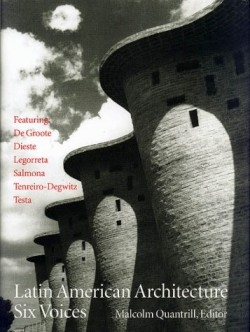Latin American Architecture
Six Voices
In the 1940s and 1950s, Latin America embraced the avant-garde modern movement. In their desire to belong to the contemporary world, leaders in Latin America adopted European symptoms of modernity, especially in its architecture. Latin American architects such as Luis Barragan and Carlos Villanueva successfully evolved modern concepts to suit their local conditions. But the modern experiment collapsed due to extreme poverty, ecological disasters and strained social conditions. This anthology samples the work of architects today who are continuing to develop the modernist aesthetic.
Framptom is renowned for writing extensively on modern architectural history and theory. His major works include Modern Architecture: A Critical History and Studies in Tectonic Culture. Malcolm Quantrill, who is also widely published, co-edited this collection. In this collection of essays, they present a survey of six significant architects throughout Latin America. Represented here are Eladio Dieste from Uruguay, Christian de Groote from Chile, Ricardo Legorreta from Mexico, Rogelio Salmona from Colombia, Jesus Tenreiro-Degwitz from Venezuela and Clorindo Testa from Argentina. Each was chosen for “creating an architecture of world stature.” Each essay is written by an indigenous critic.
All of the architects represented are heavily influenced by their European predecessors; Le Corbusier, Gropius, Kahn and Aalto, among others, are consistently cited as early influences. Yet each of the architects attempts to move beyond the modernist principles, using culturally revelant vocabulary and “attending … to local circumstances, techniques, and ways of life.” In his structures, Eladio Dieste explores the use of indigenous baked clay; the Atlantida Church has a “rippling wall of bricks” with punched openings that result in dramatic lighting in the interior space. Ricardo Legorreta continues Barragan’s development of regional architecture with his use of massive structures and thick walls. He uses interior details typical of local crafts. His Hotel Camino Real in Cancun is “sober and elegant,” nestled within the sand dunes in order to avoid intruding upon its natural background.
Sometime after the 1950s, the international architectural community lost interest in Latin America. With this collection, Framptom attempts to begin to bridge this gap. The essays included here give a scholarly overview of each architect’s work, with representative photos and drawings included at the end. Frampton acknowledges that this anthology can only be a partial view of Latin American architecture today. But the caliber of the work shown here demonstrates that these architects deserve greater renown.
Reviewed by
Jill Blue Lin
Disclosure: This article is not an endorsement, but a review. The publisher of this book provided free copies of the book to have their book reviewed by a professional reviewer. No fee was paid by the publisher for this review. Foreword Reviews only recommends books that we love. Foreword Magazine, Inc. is disclosing this in accordance with the Federal Trade Commission’s 16 CFR, Part 255.

